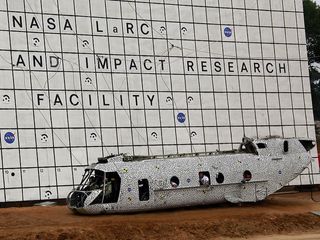NASA Drops Chopper in Crash Test

Editor's Note: This article was updated at 5:00 p.m. ET.
NASA researchers intentionally dropped a helicopter fuselage packed with crash test dummies on Wednesday (Aug. 28) to collect data intended to improve aircraft safety.
Around 1:15 pm ET, the chopper body was hoisted 30 feet (9 meters) into the air by cables attached to a huge gantry at NASA's Langley Research Center in Hampton, Va. About 10 minutes later, the fuselage was dropped, and it slammed into the ground with a thud. NASA officials said earlier this week that the airframe would hit the ground at 30 mph (48 km/h).
There were 13 instrumented crash test dummies and two uninstrumented manikins inside the aircraft, which, all told, weighed 10,300 lbs. (4,672 kg). The lifeless occupants included a a side-facing dummy and one that was lying down like a person on a medical stretcher. Images of the aftermath showed some of the dummies pitched forward in their seats and others strewn about the cabin. [Photos: NASA Conducts Crash Test of Chopper Body]
To monitor how the vehicle and the dummies handled the impact, the researchers had installed a suite of cameras and sensors inside and outside the helicopter, including an Xbox Kinect, a motion-sensing device used to play video games.
"Preliminary observations indicate good data collection, which will take months to analyze," a statement from Langley read.

The test was supposed to mimic a survivable crash scenario, and the data collected will help researchers improve safety features like seat belts.
Sign up for the Live Science daily newsletter now
Get the world’s most fascinating discoveries delivered straight to your inbox.
"We designed this test to simulate a severe but survivable crash under both civilian and military requirements," NASA lead test engineer Martin Annett said in a statement. "It was amazingly complicated with all the dummies, cameras, instrumentation and the collaborators, but it went well."
The airframe used in the test once belonged to a CH-46 Sea Knight owned by the U.S. Marine Corps. One side of it was painted white with black polka dots, though not for aesthetic reasons. In a rapid-fire series of pictures taken from the ground, those dots will act as data points so that the researchers can reconstruct the crash to see just how the chopper's body bent and broke when it hit the ground.
Though the crash is instantaneous, these tests can take years to plan. The researchers say they are planning a 2014 crash test of a similar helicopter outfitted with additional materials, such as composite airframe retrofits. The tests was a collaboration between NASA, the U.S. Navy, U.S. Army and Federal Aviation Administration.
Follow Megan Gannon on Twitter and Google+. Follow us @livescience, Facebook & Google+. Original article on LiveScience.











